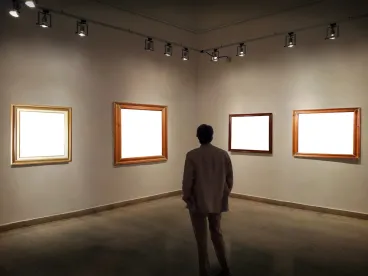Online non-fungible token (NFT) marketplace OpenSea recently collaborated with a popular decentralized autonomous organization (DAO), Friends with Benefits (FWB). As part of the project, OpenSea commissioned ten contemporary artists, who are members of the DAO, to create “phygital” (i.e., physical and digital) artworks that were featured on the marketplace’s homepage. The artworks were displayed both online and in real life at a FWB festival and conference in mid-August 2022.

FWB is a network of collaborators with more than 3,000 active members that features creators, thinkers and developers focused on shaping Web3. DAOs akin to FWB have gained significant popularity in Web3 over the past year. DAOs are without central leadership and the decisions of each are proposed and voted on by members. A majority of DAOs have rules contained in “smart contracts” that allow for most internal disputes to be easily resolved and for the community to efficiently decide on initiatives. For example, FWB put to a vote whether to partner with OpenSea, and the community overwhelmingly approved the initiative. Moreover, the community worked collectively to assemble a team of curators to oversee the partnership.
DAOs’ Background
DAOs have been used by many projects as a way to engage community members while providing a sense of utility for owners of the crypto-assets. Three states – Wyoming, Tennessee and Vermont – have moved forward with regulating DAOs. The DAO-friendly laws have been criticized for requiring premature operational decisions for entities that often begin as a loose group of members connected by social media platforms. The attempts at regulation, however, are evidence that regulators are paying attention to the significance of DAOs and Web3 in the contemporary business world.
However, unless a DAO is formed under one of the DAO-specific laws that extend traditional legal protections of formal legal structures to DAO members, DAO members run the risk of being exposed to personal liability if a DAO is considered to be a general partnership. This issue presently is being litigated in the first-ever putative class action of its kind, pending before the Southern District of California. In Sarcuni et al. v. bZx DAO et al. (S.D. Cal., May 2, 2022), members of a DAO filed a class-action lawsuit against the founders of the DAO and individuals and companies that invested in the DAO. The lawsuit arises from a data breach that resulted in the loss of $55 million in cryptocurrency for the DAO. The plaintiffs are alleging the DAO breached its duty to keep the project safe despite the “entity” being a decentralized autonomous organization. The allegation that the DAO is a general partnership is a focal point of the lawsuit, because if the DAO is considered a general partnership, members might be held jointly and severally liable for the DAO’s wrongdoing.
Intellectual Property Disputes
Aside from the corporate governance issue, the “open to the public” nature of DAOs is expected to generate a multitude of intellectual property disputes arising from the general public’s lack of familiarity with intellectual property matters. Specifically, the involvement of members of DAOs in the curation and production of artworks could muddy the waters regarding copyright and ownership for several reasons:
-
First, eventually DAOs may commission artworks, meaning a syndicate, rather than an individual creator, may own a copyright to the commissioned piece if the commission is correctly set up as a “work-for-hire” agreement. The Copyright Act contains very specific requirements for work-for-hire agreements, and failure to follow these requirements may result in failure to transfer the relevant rights in the manner that the parties intended. Museums and galleries interested in exhibiting “phygital” pieces will need to be mindful of who is the correct rights’ holder and possibly secure licenses from all parties involved.
-
Second, artists within DAOs will likely be amenable to assigning their copyright to the DAOs, further empowering those entities. But what if the artist incorporated another person’s work into their artwork without securing rights to do so? To avoid substantial litigation, the DAOs and those who partner with them in exhibiting artworks may need to put appropriate contractual provisions in place (such as through representations and warranties from the original creator) that no third-party work was involved or that appropriate assignments were secured by the original creator. Well-intentioned but misplaced trust that a member’s work does not infringe on another’s copyright could result in serious legal consequences for the DAO and its individual members.
-
Furthermore, if the DAO members elect to create a joint or a collaborative artwork, who owns the copyright and who can license rights become even more complex issues. A joint work is authored when two or more people intend that their contribution will be merged into inseparable parts of a unitary whole. Under the Copyright Act, joint authors are joint owners of the copyright to the entire work, but unless agreed otherwise each co-author can freely exploit the joint copyrighted work, subject to a duty to account for any economic benefits to the other co-owner (i.e., form licensing). An exclusive license cannot be granted without consent of all the co-owners. A co-owner’s interest in the copyright also cannot be assigned without their consent. Having several artists claim joint copyright ownership for a single artwork could be overly burdensome for individuals seeking to license the right to derivative pieces – a common practice in the NFT sector.
Needless to say, while a DAO might benefit a community, when it comes to intellectual property rights, an already complex issue becomes more complicated.
A Look Ahead
The partnership between OpenSea and FWB will not be a one-off occurrence. Decentralized curation is a breath of fresh air for the art industry. Museums and galleries have been integrating NFTs into their portfolios and devoting significant effort to attract Web3 netizens. By following the route taken by OpenSea and FWB, museums and galleries may be forced to concede to the members of the public the decision of what is exhibited, and each institution will need to decide with what degree of curatorial control or lack thereof they are comfortable, and balance that against the potential that such projects will generate much needed revenue by appeasing the DAO community.
As we have seen, the use of DAOs by institutions is not without pitfalls. As more DAOs use the community approach to generating art, their transactional counterparts need to be particularly sensitive in properly addressing copyright and other intellectual property questions for any transactions. In addition, without the proper regulatory scheme that reflects the reality of DAOs, many DAOs may run the risk of exposing every member to joint and several liability.



 />i
/>i
